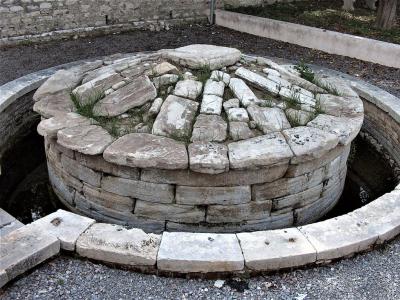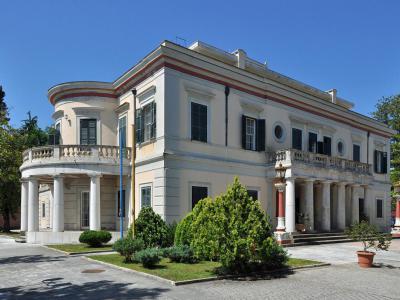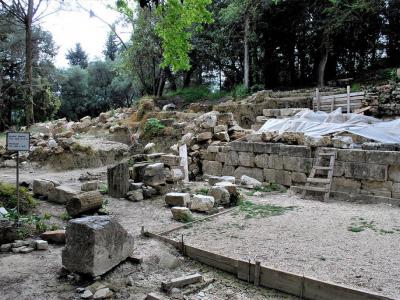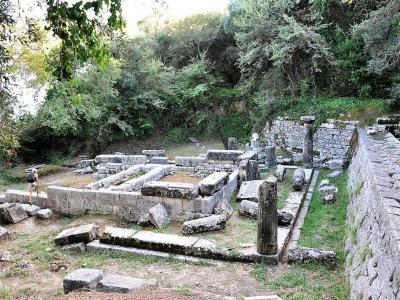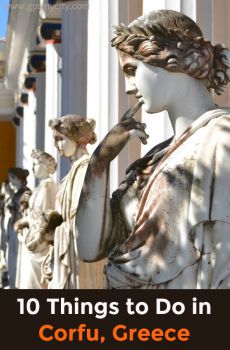
Paleopoli Ancient Ruins Walking Tour (Self Guided), Corfu
The Archeological sites trace the history of ancient Corfu from the 8th century BC to the 6th century AD. The Temple of Artemis Gorgon, located near the monastery of Agoi Theodori Stratias, dates from circa 590 BC. The pediment is thought to be the oldest stone pediment found.
Artemis, in the form of Gorgon, is running as she faces the observer. Her children, Chryssaor and Pegasus, are by her side. Two lion panthers and scenes from the Battle of the Titans are also shown. The pediment measures 38 feet by 13 feet. It is kept in the Archeological Museum of Corfu.
The Temple of Kardaki, inside the Mon Repos estate, is Dorian and dates from the 6th century BC. The temple is likely to be sacred to Apollo and Asclepius. Built on the slope of Analipsi and facing the sea, the temple is just above the magical spring of Kardaki.
Kerameikos in Figaretto is the section where the workshops of the ancient city were located. It has furnaces made from ceramic dating up to the Roman period. A statue of Artemis was discovered in the sanctuary.
The monument or cenotaph of Menecrates was found in an ancient municipal necropolis. A funerary lion of marble was found nearby. Menecrates was an official who was lost at sea. The lion is kept at the Archeological Museum.
In Benitses, a very touristy place can be found the Roman Baths. The Baths are located on the Kapsokavvadi Family estate. There is a mosaic floor, a large room with clay pipes, and the hypocaust underneath. The baths are kept in good condition.
The Early Christian Basilica by the entrance to Paleopoli dates from 450 AD. Today only parts of the apse and the walls remain. Some remains are in the Byzantine Museum.
Artemis, in the form of Gorgon, is running as she faces the observer. Her children, Chryssaor and Pegasus, are by her side. Two lion panthers and scenes from the Battle of the Titans are also shown. The pediment measures 38 feet by 13 feet. It is kept in the Archeological Museum of Corfu.
The Temple of Kardaki, inside the Mon Repos estate, is Dorian and dates from the 6th century BC. The temple is likely to be sacred to Apollo and Asclepius. Built on the slope of Analipsi and facing the sea, the temple is just above the magical spring of Kardaki.
Kerameikos in Figaretto is the section where the workshops of the ancient city were located. It has furnaces made from ceramic dating up to the Roman period. A statue of Artemis was discovered in the sanctuary.
The monument or cenotaph of Menecrates was found in an ancient municipal necropolis. A funerary lion of marble was found nearby. Menecrates was an official who was lost at sea. The lion is kept at the Archeological Museum.
In Benitses, a very touristy place can be found the Roman Baths. The Baths are located on the Kapsokavvadi Family estate. There is a mosaic floor, a large room with clay pipes, and the hypocaust underneath. The baths are kept in good condition.
The Early Christian Basilica by the entrance to Paleopoli dates from 450 AD. Today only parts of the apse and the walls remain. Some remains are in the Byzantine Museum.
How it works: Download the app "GPSmyCity: Walks in 1K+ Cities" from Apple App Store or Google Play Store to your mobile phone or tablet. The app turns your mobile device into a personal tour guide and its built-in GPS navigation functions guide you from one tour stop to next. The app works offline, so no data plan is needed when traveling abroad.
Paleopoli Ancient Ruins Walking Tour Map
Guide Name: Paleopoli Ancient Ruins Walking Tour
Guide Location: Greece » Corfu (See other walking tours in Corfu)
Guide Type: Self-guided Walking Tour (Sightseeing)
# of Attractions: 7
Tour Duration: 2 Hour(s)
Travel Distance: 3.9 Km or 2.4 Miles
Author: nataly
Sight(s) Featured in This Guide:
Guide Location: Greece » Corfu (See other walking tours in Corfu)
Guide Type: Self-guided Walking Tour (Sightseeing)
# of Attractions: 7
Tour Duration: 2 Hour(s)
Travel Distance: 3.9 Km or 2.4 Miles
Author: nataly
Sight(s) Featured in This Guide:
- Archaeological Museum of Corfu
- Tomb of Menecrates
- Temple of Artemis
- Early Christian Basilica of Saint Kerkyra
- Museum of Palaiopolis-Mon Repos
- Temple of Hera
- Kardaki Temple
1) Archaeological Museum of Corfu
The Archeological Museum building is relatively new. It was built in 1965 on land donated by the City of Corfu. Originally, it was meant to house artifacts found among the remains of the ancient Temple of Artemis.
The museum is s two-story Art Deco modernist building in Corfu. In 1994 rooms were added to house the growing collections from within the bounds of Corfu. The museum has artifacts from the Kerkyraean Cassiope section of the island and excavation finds from Bronze Age Thesprotia (part of the proto-Greek region in the late Bronze Age).
The exhibits present the Borgo pediment from 590 BC; the Lion of Menecrates, from the cenotaph of Menecrates, 7th century BC; a head of a youth of Kerkyraean poros from 6th century BC; a Laconian bronze figure of a running party-goer; a marble torso of Apollo, 2nd century AD; urns with coins and a torso of another youth of 525 BC.
There is a funerary stele that reads: "Greetings Philistion. You went twenty-three years old in the underworld and left your mother Arpalis in mourning, your husband Aristandros widower and confused, and the children cold as orphans. You,....having chosen for yourself the last sleep, this bitter, pitch-dark tomb has accepted you."
The museum is s two-story Art Deco modernist building in Corfu. In 1994 rooms were added to house the growing collections from within the bounds of Corfu. The museum has artifacts from the Kerkyraean Cassiope section of the island and excavation finds from Bronze Age Thesprotia (part of the proto-Greek region in the late Bronze Age).
The exhibits present the Borgo pediment from 590 BC; the Lion of Menecrates, from the cenotaph of Menecrates, 7th century BC; a head of a youth of Kerkyraean poros from 6th century BC; a Laconian bronze figure of a running party-goer; a marble torso of Apollo, 2nd century AD; urns with coins and a torso of another youth of 525 BC.
There is a funerary stele that reads: "Greetings Philistion. You went twenty-three years old in the underworld and left your mother Arpalis in mourning, your husband Aristandros widower and confused, and the children cold as orphans. You,....having chosen for yourself the last sleep, this bitter, pitch-dark tomb has accepted you."
2) Tomb of Menecrates
Sometime around 600 BC, Menecrates, son of Tlasias and ambassador of Korkyra to Oiantheia (modern-day Galaxidi), was lost at sea. Perhaps there was a battle or pirates. The Korkyreans were determined to honor him with a monument. Praximenes, brother of Menecrates, came from Oiantheia to help with the cenotaph.
In 1843, while demolishing a fortification in Corfu, British soldiers unearthed the cenotaph of Menecrates. The story of Menecrates' disappearance was inscribed on the tomb. A funerary sculpture of a lion was uncovered with the memorial. The lion and the tomb were found in an area known as a necropolis of ancient Korkyra.
The monument and the lion were made of limestone. The monument is a stone cylinder with a conical roof. The conical cover has stones radiating down from a rectangular capstone. The cylinder wall is made of five circular rings in an isodomic construction ( an ancient wall construction technique of finely cut and worked stone). The tomb is almost five feet high and over 15 feet in diameter.
The lion was found near the cenotaph and most likely belongs to it. There is some speculation the lion may belong to the tomb of the warrior Arniadas, who had distinguished himself at a battle by the river Arachthos. The style of the sculpture is Assyrian, and it is in excellent condition. It is kept at the Archeological Museum.
In 1843, while demolishing a fortification in Corfu, British soldiers unearthed the cenotaph of Menecrates. The story of Menecrates' disappearance was inscribed on the tomb. A funerary sculpture of a lion was uncovered with the memorial. The lion and the tomb were found in an area known as a necropolis of ancient Korkyra.
The monument and the lion were made of limestone. The monument is a stone cylinder with a conical roof. The conical cover has stones radiating down from a rectangular capstone. The cylinder wall is made of five circular rings in an isodomic construction ( an ancient wall construction technique of finely cut and worked stone). The tomb is almost five feet high and over 15 feet in diameter.
The lion was found near the cenotaph and most likely belongs to it. There is some speculation the lion may belong to the tomb of the warrior Arniadas, who had distinguished himself at a battle by the river Arachthos. The style of the sculpture is Assyrian, and it is in excellent condition. It is kept at the Archeological Museum.
3) Temple of Artemis
Artemis, daughter of Zeus and Leto, the twin sister of Apollo, was the Goddess of the Moon, wild animals, chastity, and childbirth. A temple was dedicated to her in Korkyra (Corfu) in about 580 BC. It was found on the land of the Saint Theodore Monastery in the suburb of Garitsa. It was the first all-stone Doric temple.
The temple was peripteral, surrounded by a portico with columns. It had a width of 77 feet and a length of 161 feet. It was oriented to the east so the interior would fill with light at sunrise. The immense rectangular altar was in front of the temple. The monastery was partly built over the altar.
The ruins were first uncovered during the Napoleonic Wars by troops of the French general Francois-Xavier Donzelot as they were digging trenches. German emperor Wilhelm II busied himself with excavations in Corfu. He had an "obsession" with Gorgon Medusa's sculpture on the pediment of the temple.
Only the foundation of the temple and associated fragments remain on the site. Despite this, the found remains were enough to establish an architectural reconstruction of the temple. The pedimental sculptures of the Gorgon, her children Pegasus and Khrysaor, and the flanking guardian panthers are kept at the Archeological Museum.
The temple was peripteral, surrounded by a portico with columns. It had a width of 77 feet and a length of 161 feet. It was oriented to the east so the interior would fill with light at sunrise. The immense rectangular altar was in front of the temple. The monastery was partly built over the altar.
The ruins were first uncovered during the Napoleonic Wars by troops of the French general Francois-Xavier Donzelot as they were digging trenches. German emperor Wilhelm II busied himself with excavations in Corfu. He had an "obsession" with Gorgon Medusa's sculpture on the pediment of the temple.
Only the foundation of the temple and associated fragments remain on the site. Despite this, the found remains were enough to establish an architectural reconstruction of the temple. The pedimental sculptures of the Gorgon, her children Pegasus and Khrysaor, and the flanking guardian panthers are kept at the Archeological Museum.
4) Early Christian Basilica of Saint Kerkyra
Saint Kerkyra, the first woman martyred in Corfu, wears a crown and holds a scepter in a painting in the monastery of Mount Pantocrator. Daughter of Cercillinus, the Roman governor, she was killed by her father in 70 AD. Celebrated as a martyr-saint, she guards hidden treasures in the catacombs of the early Christian Basilica in Corfu.
The early Christian basilica dedicated to Saint Kerkyra is near the estate of Mon Repos ("My Rest"), the old summer retreat of King George I of the Hellenes. The Byzantine basilica was built sometime before 450 AD on a site chosen by Jovian, Bishop of Corfu. It had been the location of a Roman odeum, used for performances of music and poetry.
The basilica, now in ruins, had two aisles and a central nave. It was a hall-type structure covered with a wooden roof. It suffered destruction several times by Vandals and Goths in the 6th century, Saracens and Normans in the 11th century, and the Turks in 1537.
Rebuilt in the 11th century and again in 1680, it had three aisles and a narthex. The basilica was destroyed again in the bombing raids of World War II. In 1968, the early architectural parts were stored in the Old Palace Museum. The mosaic floor was restored in 1960 and 1968. Only bits of the apse and walls remain on site today.
The early Christian basilica dedicated to Saint Kerkyra is near the estate of Mon Repos ("My Rest"), the old summer retreat of King George I of the Hellenes. The Byzantine basilica was built sometime before 450 AD on a site chosen by Jovian, Bishop of Corfu. It had been the location of a Roman odeum, used for performances of music and poetry.
The basilica, now in ruins, had two aisles and a central nave. It was a hall-type structure covered with a wooden roof. It suffered destruction several times by Vandals and Goths in the 6th century, Saracens and Normans in the 11th century, and the Turks in 1537.
Rebuilt in the 11th century and again in 1680, it had three aisles and a narthex. The basilica was destroyed again in the bombing raids of World War II. In 1968, the early architectural parts were stored in the Old Palace Museum. The mosaic floor was restored in 1960 and 1968. Only bits of the apse and walls remain on site today.
5) Museum of Palaiopolis-Mon Repos (must see)
Since 2001, the villa and estate of Mon Repos (My Rest), located in the forest of Palaiopolis, has been used to house the Museum of Palaiopolis-Mon Repos. The name Mon Repos was given to the villa by King George I of the Hellenes. He received the villa as a summer residence from a united Greece in 1864.
The villa was built in 1831 for the British Lord High Commissioner of the United States of the Ionian Islands, Frederick Adam. In 1833 it housed a school of fine arts. The park around the villa was opened to the public in 1834. It was a royal summer residence until 1967, when King Constantine II, the last king of Greece, fled the country.
The villa at the Mon Repos estate is a perfect example of Neoclassicism of the Regency era. The permanent display is spread throughout 14 galleries. The uppermost floor hosts temporary exhibitions and cultural events.
In the galleries are archeological finds, documents, prints, and photos. The mansion contains Regency-style furniture, objects, and a collection of watercolors and botanicals. The estate covers 260 acres of trees, temple ruins, and the botanical gardens of the Ionian Academy.
On the northeastern shore is the ancient well of Kardaki. It is said if a stranger drinks from this well, he will stay in Corfu forever. Overlooking the sea is the cave of Nymphs and an ancient theatre. In the Mon Repos area, one may find the temples of Hera, Artemis, and Apollo.
The villa was built in 1831 for the British Lord High Commissioner of the United States of the Ionian Islands, Frederick Adam. In 1833 it housed a school of fine arts. The park around the villa was opened to the public in 1834. It was a royal summer residence until 1967, when King Constantine II, the last king of Greece, fled the country.
The villa at the Mon Repos estate is a perfect example of Neoclassicism of the Regency era. The permanent display is spread throughout 14 galleries. The uppermost floor hosts temporary exhibitions and cultural events.
In the galleries are archeological finds, documents, prints, and photos. The mansion contains Regency-style furniture, objects, and a collection of watercolors and botanicals. The estate covers 260 acres of trees, temple ruins, and the botanical gardens of the Ionian Academy.
On the northeastern shore is the ancient well of Kardaki. It is said if a stranger drinks from this well, he will stay in Corfu forever. Overlooking the sea is the cave of Nymphs and an ancient theatre. In the Mon Repos area, one may find the temples of Hera, Artemis, and Apollo.
6) Temple of Hera
The Temple of Hera, or Heraion, was probably built circa 610 BC in the ancient city of Korkyra, also known as Palaiopolis. It is located within the Mon Repos estate. Hera's sanctuary is considered an early piece of Archaic Greek architecture.
The temple roof was adorned with lions, gorgons, and abstract-looking Daidala maidens painted in bright colors. It was among the most decorated temples of Archaic Greece. The temple had stone columns from the beginning establishing that Doric architecture had made rapid strides around 600 BC.
The Temple of Hera was erected at the top of Analipsis Hill, which made it easily visible to ships passing Korkyra. The Digital Archaic Heraion Project at Mon Repos has begun to digitize fragments found at the Corfu Heraion. The goal is to reconstruct in 3D virtual space Temple at Palaiopolis.
A major fire destroyed the temple in the 5th century BC. It was rebuilt as a new temple in the 4th century. The reconstructed temple was ruined again in the Venetian and Byzantine eras, mostly by looting stones.
The temple roof was adorned with lions, gorgons, and abstract-looking Daidala maidens painted in bright colors. It was among the most decorated temples of Archaic Greece. The temple had stone columns from the beginning establishing that Doric architecture had made rapid strides around 600 BC.
The Temple of Hera was erected at the top of Analipsis Hill, which made it easily visible to ships passing Korkyra. The Digital Archaic Heraion Project at Mon Repos has begun to digitize fragments found at the Corfu Heraion. The goal is to reconstruct in 3D virtual space Temple at Palaiopolis.
A major fire destroyed the temple in the 5th century BC. It was rebuilt as a new temple in the 4th century. The reconstructed temple was ruined again in the Venetian and Byzantine eras, mostly by looting stones.
7) Kardaki Temple
The water fountain stopped flowing in 1822. It had never done that in living memory. The British engineers discovered the channel was blocked by stones. The stones came from a temple heretofore unknown. They had found the Temple of Kardaki, what was left of it. More discoveries were made in 1911-1914 by German archeologist Wilhelm Dorpfeld.
The Temple of Kardaki is located in the park of the Mon Repos estate on the east side of the peninsula of Analipsis. It dates from the late Archaic Era, circa 510 BC. The name is taken from the Kardaki fountain, close by. At first, it was thought the temple was dedicated to the god Apollo, but there was no proof.
Further excavations seemed to indicate both Poseidon and Asclepius as the venerated deities. It is a Doric temple, small, 39 feet by 84 feet in area. Despite being Doric in character, it had some Ionic elements. It has six columns on its narrow sides and 12 on the long sides. A central rectangular shape might be the riser of a statue.
The temple is unusual. It has no frieze. In this way, it resembles some Sicilian temples. It is thought to be the only Doric-style Greek temple. Water still flows from the spring of Kardaki. Some say to drink the water will make a traveler wish to stay forever. Could it be the gods are still at work?
The Temple of Kardaki is located in the park of the Mon Repos estate on the east side of the peninsula of Analipsis. It dates from the late Archaic Era, circa 510 BC. The name is taken from the Kardaki fountain, close by. At first, it was thought the temple was dedicated to the god Apollo, but there was no proof.
Further excavations seemed to indicate both Poseidon and Asclepius as the venerated deities. It is a Doric temple, small, 39 feet by 84 feet in area. Despite being Doric in character, it had some Ionic elements. It has six columns on its narrow sides and 12 on the long sides. A central rectangular shape might be the riser of a statue.
The temple is unusual. It has no frieze. In this way, it resembles some Sicilian temples. It is thought to be the only Doric-style Greek temple. Water still flows from the spring of Kardaki. Some say to drink the water will make a traveler wish to stay forever. Could it be the gods are still at work?
Walking Tours in Corfu, Greece
Create Your Own Walk in Corfu
Creating your own self-guided walk in Corfu is easy and fun. Choose the city attractions that you want to see and a walk route map will be created just for you. You can even set your hotel as the start point of the walk.
Corfu Old Town Walking Tour
Poseidon, the god of the sea, was obsessed with the beautiful nymph Korkyra, the daughter of the river god Asopus. Poseidon abducted Korkyra and carried her off to an unnamed island. He called the island Korkyra, after his lady love. This island later became Corfu.
The medieval castles on the island tell of struggles in the Middle Ages against invaders like Roman-era Germanic tribes, Arabs, and... view more
Tour Duration: 1 Hour(s)
Travel Distance: 1.4 Km or 0.9 Miles
The medieval castles on the island tell of struggles in the Middle Ages against invaders like Roman-era Germanic tribes, Arabs, and... view more
Tour Duration: 1 Hour(s)
Travel Distance: 1.4 Km or 0.9 Miles
Useful Travel Guides for Planning Your Trip
10 Things To Do In Corfu, Greece
Greek Islands, such as Mykonos, Rhodes, Corfu, Santorini, and many others, are a popular destination for people trying to escape the chaotic lifestyle back home. Corfu is one island that has it all: great weather, tasty food, relaxed atmosphere and an abundance of places to explore. The island...
The Most Popular Cities
/ view all

